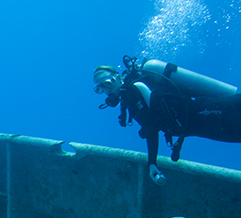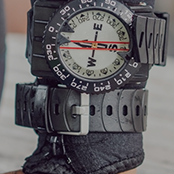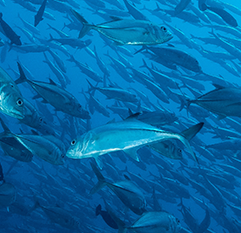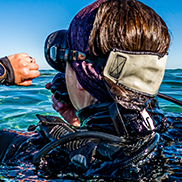“Well that explains everything…”

Marketing SCUBA is easier than ever

THOSE WERE NOT REALLY THE GOOD OLD DAYS AT ALL Someone brought an old travel brochure into the DRI office last week. It was about scuba diving in the ‘British Caribbean’ and was a classic piece of pre-internet marketing; definitely from a different era. It would be pretty easy to totally right it off dismissing it as irrelevant in today’s market, but — as old and completely out-dated as it is — it does have something interesting to tell us. Namely, there are so many more options for us to take advantage of now compared to when this antique was printed. You may be a little antique yourself and remember that back in the early 1990s, when it was printed, about the only option for a dive shop was to print flyers like this one, hand them out or snail-mail them to hundreds of customers — at a considerable cost per unit — and hope a significant few signed up for a trip. Worth remembering, or learning, that 30 years ago, there were no blogs, online videos, and social media posts to share informative content about scuba diving, and certainly no affiliate programs to build interest with other local retailers. In short, there was no easy way to highlight the benefits of diving, its unique experiences, the adventure it offers, any pertinent safety tips, and no personal stories on social media to help build a sense of community; nothing to share any of the excitement and beauty of diving. Also, there was no nitrox, way fewer specialty programs, no “technical” diving, no overhead training — like advanced wreck or cavern and cave — and aids like oxygen administration and compressor operator courses were totally off-limits. And nothing to promote rebreathers, DPVs, twinsets or sidemount. Nothing beyond the basics to up-sell and retain customers. Plus, the brochure mentioned nothing about special events, like equipment workshops, in-store book signings, or show-and-tell nights promoting upcoming trips. (Of course, back then, there was no simple way except perhaps a sign in the store window, to let people know any of this was happening.) It’s true that the basic rules of marketing are unchanged. It’s still the case that selling everything from a large-screen TV and flat box furniture to a scuba diving course primarily involves identifying your target audience, recognizing what they are looking for, and then targeting your message to appeal to them. And in the diving world we all understand that another constant is that if your local diving is focused on tropical reefs and big pelagic wildlife, your message (and the courses and equipment you push) will not be the same as the shop within an hour’s drive of fantastic wooden wrecks preserved by four-degree freshwater. All that and perhaps that dive trips to exotic destinations have a universal appeal, and hopefully always will. You may not be taking full advantage of all of the online and associated marketing strategies available in 2024. You may not use smart apps and CRM software to regularly engage your customers. And you may not have learned to adjust your approach based on feedback and results from previous marketing efforts — easily captured by a whole raft of online tools — but we are sure that you have a much easier time of it when a four-colour printed brochure was all there was! We’re not suggesting marketing is easy today, but it is a whole lot easier than in the good old days.
For Divers by Divers…

ISN’T THE RAID WATCHWORD TRUE OF ALL AGENCIES? One of our shareholders was recently asked to respond to a dive instructor who questioned our call to join Dive RAID International because it’s an agency built by divers for divers. He claimed that statement is “verbose [sic] and a claim to exclusivity that needs some validation and verification.” Challenge accepted! Our shareholder wrote back: “Thanks for your question! While it’s true that many agencies have been founded by divers, what makes RAID different is that our philosophy and operations are driven entirely by divers, for the benefit of divers. “Unlike some agencies where business or corporate interests tend to influence decisions, at RAID, everything from course development to instructor support is shaped by active, experienced divers who understand the needs of the community firsthand. “Our goal isn’t just to certify divers; it’s to enhance the entire diving experience through constant innovation, flexibility, and by putting divers at the heart of what we do. That’s the difference we stand by!” In the proverbial nutshell, our shareholder summed up EXACTLY what RAID is all about. If she’s had more space, she might have added, all that and everything related to following a skills-based, inclusive approach to training and doing business that seeks to bring value and positive change to the dive industry. And if that sounds like your kind of outfit… WHY NOT JOIN US!?
Protected: This program is like insurance you hope you never claim
There is no excerpt because this is a protected post.
WHY RAID

Part of the adventure is getting a chance to look at what’s called “industrial archeology.” For many of us, that translates into simply taking a look at what’s down there!
WHY RAID

Stay Active, Stay Interested, Stay Diving.
With RAID, You Know What You’re Getting…

AND YOU CAN TELL US WHAT YOU GOT We’ve really tried hard to let divers know exactly what to expect from a RAID class… from an entry-level, open water diver whose adventure is just starting, all the way to a CCR cave diver exploring the darkness 100 metres deep. It starts with FREe-Learning. FREe-Learning opens access to every RAID manual in our library. (Just to be clear, that includes core programs, freediving courses, recreational, DM, Instructor, technical… everything: even the end of chapter quizzes.) And yes, it’s free, and you’re invited! And, not only is it free, it’s ultra convenient too because if you like what you see, the online system lets you pick a local RAID dive centre and sign up for the class on the spot. {LINK} But, all that aside, we also try hard to make sure you (every student for every class in fact) get value for your time and money. At the end of a RAID class, there is a short questionnaire. It lists the skills required by our class standards, and asks if all of them were covered in the class. It’s a basic quality assurance to make sure you got what you paid for. The final piece is an online logbook for each student to log their dives. Certainly, logging the dives associated with the class they just finished, but the app is available anytime for any dive. RAID is about skill-based learning… AKA competency-based learning. We put strong emphasises the importance of practical skills and diver competence throughout a student’s long-term development with the agency. RAID goes beyond traditional knowledge-based learning, which primarily focuses on theory and information retention. Our approach aims to create divers who are committed, confident, and comfortable. That’s The RAID Way™ and that’s our promise.
We Know the Way… Just Ask

RAID NAVIGATION SPECIALTY IS “ON SPECIAL” You need to know where it’s at… and where you’re at too. So, your best bet is to signup for a RAID navigation specialty because it’s an essential for any new diver… or older divers who have trouble finding their way home! Underwater navigation involves using various techniques and tools to effectively orient yourself and navigate while diving. Here are some of the key methods and tips for underwater navigation you will learn in RAID’s navigation class: 1. Natural Navigation: 2. Compass Navigation: 3. Dive Planning: 4. Dive Safety: 5. Buoyancy Control: 6. Using Dive Computers: 7. Practice: By mastering these navigation techniques, SCUBA divers can explore underwater environments more safely and effectively while minimizing the risk of getting lost. This RAID specialty is port of our comprehensive core diver experience.
DEEP 40 Part of a Solid Foundation

SEPTEMBER SPECIALS SCUBA diving to 40 meters (approximately 130 feet) deep is no simple matter… well, getting down is easy, but fixing things so that the way back up is uneventful, takes some care. RAID’s Deep 40 program will introduce students to the careful planning and additional skills that make diving to the limit of the recreational dive tables, fun, enjoyable, and as safe as possible. Here are some important guidelines for diving at this depth which the DEEP 40 program follows: 1. Academics and Skills Coaching: This makes sure students execute the open water dives with the mindset, equipment, techniques, and background understanding to keep them at their peak. All this help to ensure that the whole Deep 40 experience is a comfortable and effective learning adventure. 2. Planning Your Dive: Deep 40 students will build a detailed dive plan, including entry and exit points, duration, and maximum depth. They will use dive tables and a dive computer to calculate no-decompression limits and safety stops. And discuss the plan with their dive team to be certain that everyone understands their role and is confident to play their part. 3. Gas Management: As divers venture deeper, gas consumption increases. A critical part of this program is detailed gas calculations for a safe bottom time, ascent, and safety stop. (Deep 40 students have the option to use use nitrox or a suitable helium-based gas. 4. Equipment: This course will introduce students to the concept of detailed pre-dive checks, and using equipment rated for deep diving. This includes a reliable dive computer or depth gauge, dual gauges for redundancy, and appropriate exposure protection (wetsuit or drysuit). And of course, regulators suitable for deep diving. 5. Environmental Concerns: There are increased potential hazards at this depth, such as cold water temperatures, strong currents, and reduced visibility. There is often different and more fragile species of marine life as a diver travels deeper and each of these poses potential risks but added responsibilities. 6. Buddy System: At any depth, following the buddy system is important, but certainly below 20 metres, its importance become more critical. Always dive with a buddy for safety. Be as sure as possibe that both divers are aware of the dive plan and can assist each other in case of an emergency. 7. Emergency Preparedness: An important part of the equipment package for deeper diving is a surface marker buoy (SMB) to signal your ascent and make your location visible to boats, and dive team members (support) on the surface. It also pays to have a clear plan in case of emergencies, including a communication plan and access to first aid or oxygen. 8. Post-Dive Considerations: After diving to these depths, avoid flying or ascending to altitudes for at least 24 hours to minimize the risk of decompression sickness. Monitor your health after the dive and seek medical attention if you experience any unusual symptoms. Diving to 40 meters can be a rewarding experience offering stunning underwater sights, but proper training, planning, and safety measures are crucial. Always respect your limits and those of your diving partner. And signup for a RAID Deep 40 program to ensure a fun and safe dive.
Lost at sea…

THEY SURFACED AND THE DIVE BOAT WAS NOWHERE TO BE SEEN The public broadcaster in the UK (the BBC) recently aired an interview with a couple of divers who spent 36 hours drifting off the Texas coast before being rescued by the US coast guard. Nathan and Kim Maker became separated from the charter boat in what was reported as bad weather and heavy seas. According to a fellow diver, the pair disappeared when “a huge swell comes in and engulfs Kim and Nathan totally. When the swell rolls out, they’re nowhere to be found.” And although the folks on the boat began to search for the pair immediately, they were gone. Few of us can imagine what it took for the Makers to hang on to their sanity and keep their spirits up while they drifted around, lost and alone. And the BBC story was a brilliant illustration of… well, the right words have to be gumption and faith. But, all that aside, is there something to be learned from their adventure… apart from never give up? As a dive agency, the answer to that simple question is, yes. We can learn something. It’s part of our job to modify what we suggest and advise students to do whenever an actual dive story presents us with an opportunity to share and learn. And this incident presents just that sort of opportunity. RAID offers a boat diving specialty. Perhaps this story points out that it’s time for an update. It’s time for our editorial team to put RAID Boat Diver on the list of course materials to be reviewed. It’s not that divers get washed away from their buddies on a regular basis, but it happens. Occasionally, too, a boat will leave a dive site when divers are still submerged. We can never make it certain that neither of these things happen again, but we can recommend some revised ‘contingency plans’! There isn’t space or time — and this isn’t the place — to deliver a whole diver manual for any RAID program, including Boat Diver. But here are some suggestions for any of you with plans to dive off-shore where tides, current, lumpy seas, or a tonne of other things might turn your day on its head. First is always carry a SMB (surface marker buoy) or a safety sausage. When diving current, a minimum of three (including a DSMB) per buddy team. is recommended. (Two for each diver is even better.) Also, carry a spool or small diver’s reel (a cavern reel is a good choice), and load it with #36 or #48 kernmantle. (Line a little stronger than the #24 line that cave divers use.) In fact, carry two. Make sure as well, that both you and your buddy have a “surface signalling device.” This could be as simple as a Fox whistle or a scuba diver’s air horn. Many recommend a signalling mirror as well. A signalling mirror is as useful as a chocolate teapot when it’s cloudy or at night. A better choice is a modern diver’s backup light (small and powerful). An alternative is a wreck-diver’s strobe light. But, in either case, do make sure the batteries are charged! There is a RAID instructor who always sits a very large, very colourful safety sausage in his place on dive boats before he jumps in the water. He explains this habit by saying: “that way, they can’t forget me.” He’s strategy seems to work and makes him a difficult passenger to miss. He has never been left behind! He is much too much of a presence for that. But for the more introverted among us, there are easier ways to track and log divers. And at very least, make sure that during post-dive roll call, your absence would be apparent. And finally, if your diving takes you well away from shore or you dive in strong currents, or your dive profiles are deep and long, we recommend packing a scuba diver’s GPS or rescue beacon in a pocket or pouch. There are several models on the market, so do a little research. They are not cheap, but they’re a bargain if they can save you and your buddy a night bobbing around in the ocean.

